Review: Netflix’s Avatar The Last Airbender – How Season One Differs From the Original
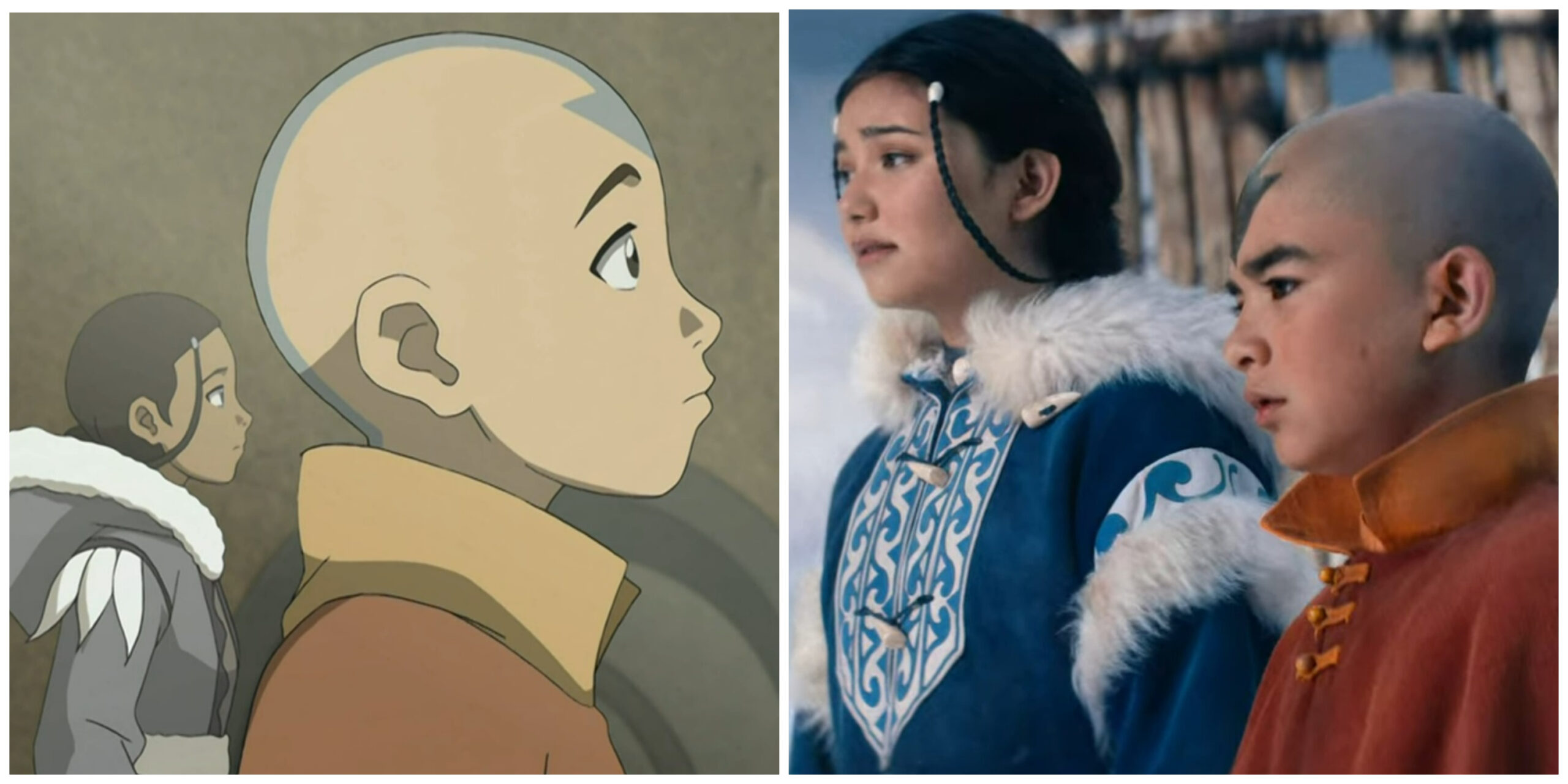
NickToons may be known for their comedy, but it’s the action-heavy Avatar the Last Airbender that seems to find its way to live action adaptations. Avatar was beloved, not just for its mix of action and fantasy, but also it’s character development, emotional resonance, and well structured plots. M. Night Shyamalan directed a theatrical adaptation in 2010 that condensed the entirety of the first season of the show into one movie. It failed for a number of reasons, and not just because of the the runtime. When Netflix tackled adapting Avatar for live action, they were able to tell the story of the first season over the course of 8 episodes, each about an hour long. With the first season of the original series consisting of 20 half hour episodes, the Netflix series had only about an hour less runtime than the first season of the original show. That means some things were kept while others were left out.
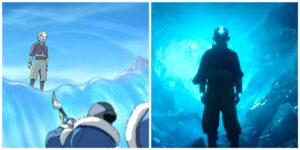
“Book One: Water” begins with Aang, having been frozen for a hundred years, discovered in the South Pole by Katara and Sokka. Aang learns about his powers and destiny as Zuko and Iroh follow his trail by sea. The season concludes with Fire Nation Admiral Zhao attacking the Northern Water Tribe during a lunar eclipse. The Netflix series essentially begins and ends the same way, hitting many of the major beats.
The Gaang go to the Southern Air Temple, Kyoshi Island, Omashu, and the Spirit World. Aang visits a Fire Nation temple to connect with Roku, is briefly captured and rescued by a disguised Zuko, and the season finale once again involves the Northern Water Tribe, Zhao, and the moon spirit.
The new series drops some of the less impactful stories, such as “The Great Divide” and “The Fortuneteller”. Other plots ended up being condensed and combined. The “Omashu” episode not only adapted “The King of Omashu”, but it also incorporated the plots of “Jet”, “The Northern Air Temple”, and even took some bits from the season two Omashu episodes.
The live action series tackles these plots while also skewing for an older audience. That means some of the more heinous acts of the Fire Nation, like their assault on the Air Nomads, were shown on screen. As a result, they lose some of the humorous elements. Whether it was a case of not wanting to appear too goofy or thinking about budget, Aang is no longer fixated on playing with and riding animals in different locales.
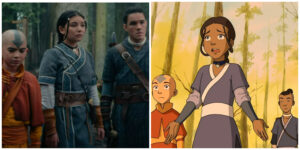
The aesthetics of the new series doesn’t try to copy the original, but there are lots of reminders. There are some familiar music stings, such as the Fire Nation’s leitmotif, and the end theme is an extended remixed version of the original. Of course, with hour-long episodes, there’s a lot more music throughout an episode than the original. Being live action, they couldn’t imitate the bright colors of the NickToon. Each Nation has its own color scheme, and the live action show remained faithful to many characters’ clothes. These colors looked more natural in animation, and clothes in the live action version were rarely shown to get torn or dirty. Hairstyles, from Katara’s hair loopies to Iroh’s beard, mostly remained faithful.
It hasn’t been that long since the cartoon, but tastes and sensibilities have changed over the years. Some elements of the original series, particularly interactions between the male and female characters, had to be updated. They dropped the running gag of Iroh hitting on the bounty hunter June, and Sokka’s sexism when on Kyoshi Island was tweaked. Pakku’s past with Katara and Sokka’s grandmother was also abandoned. There is virtually no romance between Aang and Katara. The original series teased them as early as “The Fortuneteller”, but the new series didn’t even put them together in the Cave of Two Lovers.
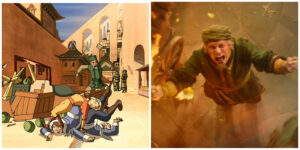 It is interesting to note how many things still find their way into the new show, some of which can be considered Easter Eggs for longtime fans. When sneaking into Omashu, Aang uses the alias “Pippinpaddleopsicopolis”, which comes up in the Netflix show when Sokka suggests it as the name for a little girl’s doll. James Sie, who voiced the cabbage merchant in the original series, reprises his role for a brief cameo in the new series.
It is interesting to note how many things still find their way into the new show, some of which can be considered Easter Eggs for longtime fans. When sneaking into Omashu, Aang uses the alias “Pippinpaddleopsicopolis”, which comes up in the Netflix show when Sokka suggests it as the name for a little girl’s doll. James Sie, who voiced the cabbage merchant in the original series, reprises his role for a brief cameo in the new series.
The changes in characters, which may be the most severe, have also been the most criticized among fans. Naturally, there is more emphasis on the actors and the emotions they convey rather than the impressive fight moves they pull off. Suki, for instance, is out of her make-up to make the actress’ expressions more visible. However, slight changes to a character’s motivation or background is going to have repercussions for their story onward. The Netflix series begins with Aang among the Airbenders. He leaves before the Fire Nation attack, but in this version, he does it after finding out he’s the Avatar as opposed to him not wanting to leave and train in the original series. We see Aang with Gyatso early on, which makes for an emotional reunion in the Spirit World that never happened in the original series. Aang also gets to interact with three past Avatars, Kyoshi, Roku, and Kuruk, at their respective temples. Past Avatars give him predictions of the future, which wasn’t a part of the Nickelodeon series. While Kyoshi did appear in season one of the original series, her backstory has been expanded since (to the point where Kyoshi starred in her own novels). Kyoshi was given more importance when Aang met her. While Roku was the first Avatar to take over Aang’s body in the original series, but it’s Kyoshi who does it in this version. Aang’s journey as the Avatar appears to be a slow one, as he doesn’t practice waterbending along with Katara, and he has yet to meet the firebending master Jeong Jeong.
The Gaang in the original series was virtually inseparable, but not so here. Given how hour long episodes divide their A, B, and C stories, the Gaang was split off into their own stories often. Elements of Sokka’s character end up missing. He spends spends less time with Aang and Katara, even if his interactions with Suki and Yue are still there. Sokka’s big episode of the first season, “Bato of the Water Tribe”, doesn’t make it into the live action version. Instead, there is an extended flashback of Sokka going through a trial while he’s in the spirit world.
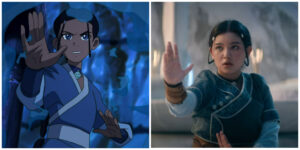 Of the main trio, Katara may suffer the most. The first season of the original series painted her as principled and strong in her resolutions while also having her battle jealousy and insecurity. Her big speeches and Team Mom tendencies were, along with entire subplots, were jettisoned in the new show. Rather than finding a waterbending scroll and fighting past her feelings of inferiority next to Aang to teach herself, Katara simply already has the scroll and practices by herself. She doesn’t have a subplot of losing her necklace to Zuko, and even meeting Jet and disagreeing with his and the Freedom Fighters’ philosophy has less bite because this Katara doesn’t speak from her emotions as much.
Of the main trio, Katara may suffer the most. The first season of the original series painted her as principled and strong in her resolutions while also having her battle jealousy and insecurity. Her big speeches and Team Mom tendencies were, along with entire subplots, were jettisoned in the new show. Rather than finding a waterbending scroll and fighting past her feelings of inferiority next to Aang to teach herself, Katara simply already has the scroll and practices by herself. She doesn’t have a subplot of losing her necklace to Zuko, and even meeting Jet and disagreeing with his and the Freedom Fighters’ philosophy has less bite because this Katara doesn’t speak from her emotions as much.
Zuko, Iroh, and the Fire Nation in general benefit from the longer episode format. Like in  the original series, Zuko is driven to capture the Avatar while Iroh is more worried about Zuko’s well being. Their relationship is broadened, as there is a flashback of Zuko comforting Iroh after the loss of his son. The navy that accompanies them is also given a connection to Zuko. Admiral Zhao gets more to do, has loftier ambitions, and his final fate is different. There are many scenes with Ozai and, while Azula is only teased at the end of Book One of the animated series, she gets an entire subplot in this version. Ozai plays Azula against Zuko, which motivates her to work harder, and she has a connection with Zhao. Even her friends Mai and Ty Lee are around.
the original series, Zuko is driven to capture the Avatar while Iroh is more worried about Zuko’s well being. Their relationship is broadened, as there is a flashback of Zuko comforting Iroh after the loss of his son. The navy that accompanies them is also given a connection to Zuko. Admiral Zhao gets more to do, has loftier ambitions, and his final fate is different. There are many scenes with Ozai and, while Azula is only teased at the end of Book One of the animated series, she gets an entire subplot in this version. Ozai plays Azula against Zuko, which motivates her to work harder, and she has a connection with Zhao. Even her friends Mai and Ty Lee are around.
Other characters go through slight changes. Bumi was simply angry with Aang and wasn’t about testing him like his animated counterpart. Koh had a different relationship with the Avatars, and Aang didn’t beat him by holding back emotion. June gets more to do as she captures Aang, but that leaves the Yuyan Archers with less of a presence. Haru doesn’t appear at all, but Jet somewhat takes his place. Given the larger budget needed for characters like Appa and Momo, they have less onscreen appearances. Momo, however, gets a focal moment in the finale he didn’t have in the original series.
 Going forward, the new series can still follow the major plot points of the original series. Sozin’s Comet served as a ticking clock for the cartoon, but without it in this version, the new show has more time to tell its story. Aang is going to have to learn and practice other elements. Some important characters, like Toph, have yet to be introduced. With the renewal of the show already announced, it’s certain there will be more changes, for better or for worse.
Going forward, the new series can still follow the major plot points of the original series. Sozin’s Comet served as a ticking clock for the cartoon, but without it in this version, the new show has more time to tell its story. Aang is going to have to learn and practice other elements. Some important characters, like Toph, have yet to be introduced. With the renewal of the show already announced, it’s certain there will be more changes, for better or for worse.
Discuss this review on the Toonzone Forums!
The post Review: Netflix’s Avatar The Last Airbender – How Season One Differs From the Original appeared first on Anime Superhero News.
